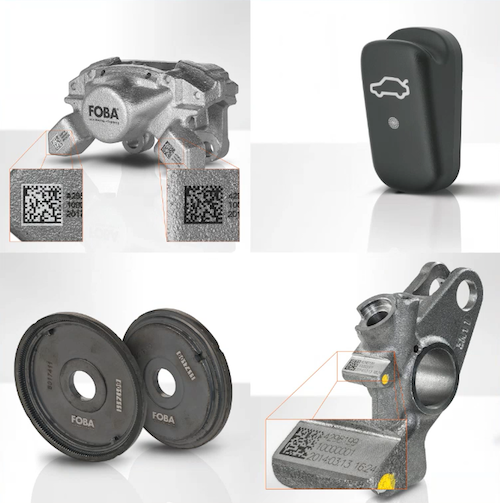
At IMTS 2018, FOBA will showcase an innovation in direct-part laser marking that removes the need for to hold components in a fixed position As Dr. Faycal Benayad-Cherif, business manager for software and vision at FOBA explains: “Today, in 95% of the laser-marking applications, automotive components must accurately be fixed to guarantee a proper alignment of the laser mark to the part.”
As Dr. Faycal Benayad-Cherif, business manager for software and vision at FOBA explains: “Today, in 95% of the laser-marking applications, automotive components must accurately be fixed to guarantee a proper alignment of the laser mark to the part.”
With FOBA’s innovative laser-marking solution Mosaic, parts can sit in any orientation or position within the marking field. The new patent-pending software feature is a powerful advancement in vision-based laser marking. It speeds up device handling and laser-marking processes while drastically reducing overhead costs. The technology brings products up to market over a shorter cycle time while significantly reducing cost of development and engineering.
Product integrity, reliability and traceability
Direct-part laser marking is being deployed for a wide range of applications in the automotive industry. Most components must be marked with traceability contents such as data matrix codes, serial numbers and other marks, eg, decorative elements or illustrative symbols on backlit plastic panels for day-night visibility.
OEM manufacturers depend on marking systems that create enduring marks on any kind of material to ensure the safe functionality and traceability of parts and products throughout the entire lifecycle. Moreover, the marking procedure must seamlessly be integrated into the production process and ensure highly efficient, reliable and error-free marking.
FOBA laser marking systems, mainly based on fibre and UV-laser technology, offer advantages for an economic and reliable production process. FOBA uses imaging technology that covers pre- and post-mark verification as well as automated mark alignment. The integrated camera prevents marking errors, which is economically significant as parts get marked at the end of the production cycle, where errors can prove particularly expensive.
Dr. Benayad-Cherif, FOBA’s Business Manager, Software and Vision, answers the most important questions about FOBA’s innovative vision-based technology for fixture-less laser marking:
How can FOBA’s laser-marking innovation best be described?FOBA’s uses a concept based on through-the-lens vision combined with the tiling of images. The exceptional image simulates a straight-down view from inside the laser with an imaging field as large as the laser marking area. The straight-down view is critical as it eliminates the need for external cameras known their perspective inaccuracies. Within a second, the part, presented in the fixture-less mode of operation, is imaged, laser-aligned and laser-marked with precision.
For automotive manufacturers, the benefits are clear. It means significant cost savings in the design, the manufacturing and the maintenance of industrial fixtures. It also offers faster and more consistent production throughput as parts can be marked accurately regardless of their placement under the laser. Other cost savings are found in the ability to run mixed parts on the same conveyor and a reduction of additional hardware for reorienting and repositioning parts. Other advantages include faster reconfiguration of conveyor lines, a reduction or even elimination of fixtures completely and a lower maintenance schedule.
What makes the new feature innovative?FOBA’s mark alignment feature with its integrated camera solves various marking issues common to the market. To guarantee properly marked parts, the industry has to date relied on custom fixtures or custom vision systems designed to compensate for part placement inaccuracies. Fixtures are notorious for being expensive, due to the extensive design engineering time and maintenance required and they typically work for one part only.
Common imaging solutions work well but still rely on some sort of low accuracy fixtures. Other approaches resort to an external camera pointing at an angle toward the laser marking area to eliminate the motion. Even though fast, this approach introduces optical distortions and significant mark inaccuracies that can limit its use and flexibility, particularly when parts are not flat.
How does this marking feature differ from other solutions on the market?FOBA’s patent-pending breakthrough in automated laser marking drastically reduces the need of fixtures. With the Mosaic feature, operators can place the part anywhere under the laser in any orientation. The mosaic image, created within a second, is used to validate the part presence, its identity and align the laser content to match the part position. Depending on the part complexity, the cost of a fixture can vary from several hundreds to many thousands of euros. A manufacturing facility that utilises a hundred or more fixtures per production site, can benefit from essential cost savings.
Before its official market release, FOBA will be showcasing Mosaic, the new marking feature, in Hall North Building at booth number 23-236024. A FOBA M2000 laser marking station, equipped with the new software and all the latest developed features like programmable structured lighting, will also be presented at the show.
Visitors can experience live presentations of the automated mark alignment working with randomly positioned sample parts.
Two more laser marking systems will be at the show: FOBA M1000 with a 20 Watt fibre laser and the IMP imaging technology as well as FOBA M3000-R with rotary table and an integrated marking laser especially designed for precise paint removal applications that create brilliant marks on backlit components (Day-night-design).































